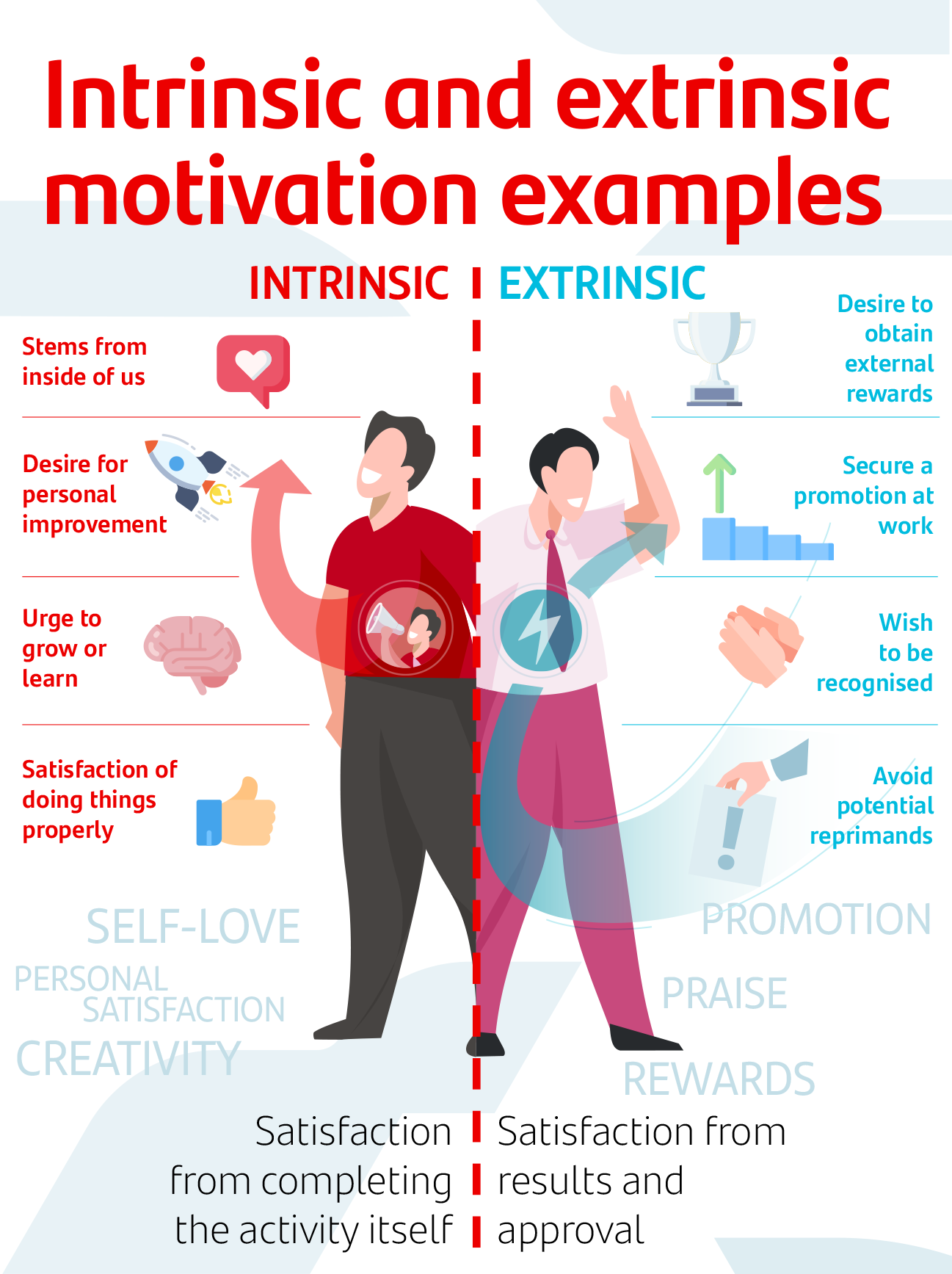Intrinsic and extrinsic motivation examples: what's the difference and why do you need them?
You're sure to know plenty of people who succeed at everything they set their minds on. You may wonder what it is that they all have in common: intelligence, perseverance, willpower, luck? While these success stories may just be down to a mix of all of the above factors, there's one ingredient that, without which, it's highly unlikely that any of these people would have achieved their goals: motivation.
There are two types of motivation: intrinsic and extrinsic. In this article you will learn all about what intrinsic and extrinsic motivation are, examples, the differences between the two types and why they will be instrumental in helping you to fulfil your dreams.

What is motivation and why is it so important?
Motivation is defined as the "set of internal and external factors that in part determine a person's actions". In other words, it is said that when a person is motivated, their actions and energies are directed towards achieving a specific goal.
Nowadays, motivation is often pinpointed as the key to success precisely because it's the catalyst for other skills that result in goals being achieved, namely, willpower, perseverance, optimism and a positive attitude, amongst others. That's why businesses that are able to motivate their employees are up to 50% more successful. Imagine being able to apply that to your life?
It's important to point out here that motivation can come from both internal and external factors. This is what makes the difference between intrinsic and extrinsic motivation.

What's the difference between intrinsic and extrinsic motivation? Examples
Although it's obvious that both intrinsic and extrinsic motivation are examples of a central part in any successful strategy, they neither imply nor are one in the same. ¿Do you know the difference between intrinsic and extrinsic motivation?
- Intrinsic motivation stems from inside of each individual, and is independent of any kind of external stimulus. The rewards that you can reap by nurturing this type of motivation are purely personal: self-love, personal fulfilment, independence, inner strength, confidence, and so on.
- Extrinsic motivation, on the other hand, is the set of measures that you pursue to obtain an external reward, the most common example of this being economic rewards, although extrinsic motivation isn't merely a quest for a better salary. Extrinsic motivation seeks personal validation from a third party: praise or psychological reinforcement are some of the key aspects of extrinsic motivation.
The main difference between the two types of motivation, therefore, lies in where the stimulus that triggers such behaviour originates from. So, if actions stem from a desire for personal improvement, an urge to grow and learn, or from the need to fulfil certain obligations by doing things properly, this would fall under intrinsic motivation.
If, on the other hand, a specific behaviour is driven by the hope of securing a promotion at work, the desire to be recognised, or even to counteract a potential reprimand (as may be the case with a punished child, for example), then these are clear extrinsic motivation examples.

Motivation as the key to success
There is no such thing as "good" or "bad" motivation. To achieve any of your goals, you will need to strike a balance between intrinsic and extrinsic motivation, both on an individual and collective level. In this sense, there are several studies on the importance of both types of motivation in the personal and professional spheres, but by far one of the best-known hypotheses on intrinsic motivation is the theory of self-determination (Edward Deci and Richard Ryan, 1975).
Psychologists and professors from the University of Rochester argue that, under this theory, intrinsic motivation arises in every human being when several needs are met:
- The need to be autonomous
- The need to relate with others
- The need to be competent
In other words, when one's own behaviour and changes to this are fueled by a personal desire to improve and to achieve such feelings of satisfaction, with no intention of receiving an external reward, we might call this motivation intrinsic. This form of motivation usually leads to the secretion of serotonin.
In turn, high levels of serotonin in the body lead to a sense of happiness, serenity, and optimism, as well as mitigating anxiety and improving cognitive processes.
In short, intrinsic motivation and a good mood go hand in hand, thus multiplying the chances of achieving your goals.
How do the two types of motivation feed into each other?
Naturally, intrinsic motivation and extrinsic motivation are not entirely independent of one another. According to a study, external rewards affect intrinsic motivation in different ways:
- Excessive external rewards for an activity that, in itself, should already have an intrinsic motivation, can end up resulting in a decrease in the latter. Don't exploit extrinsic motivation if you want to boost your intrinsic motivation!
- However, extrinsic motivation can often prove a handy tool when it comes to kick-starting an activity that you'd never get done with intrinsic motivation alone.
- Meanwhile, extrinsic motivation - in the form of social validation - for example, is closely tied with an increase in intrinsic motivation.
A good example of the feedback between intrinsic and extrinsic motivation is given in the field of training. Who wouldn't want to continue learning to expand their knowledge and become more satisfied with any work done? Moreover, this motivation, which often stems from a personal desire to improve, might also lead to a better job offer, a salary increase, etc.
If you are intrinsically motivated to continue to grow personally and professionally, then Banco Santander - with the aim of helping people to progress, overcome the challenges posed by the fourth industrial revolution, and grow in an inclusive and sustainable way - is committed to three key concepts to boost employability: lifelong learning, reskilling and upskilling. To this end, it has developed the Santander Open Academy website, a unique and pioneering global programme.
If you would like to keep growing personally and professionally, head over to the Santander Open Academy website, where you'll find 100s of opportunities to train together with internationally renowned institutions. Access training in technology, languages, research, investigation, soft skills, internships and female leadership, which will help you to improve your employability or refocus your career.
Do you want to become a lifelong learner and increase your job opportunities? The Santander Open Academy website has plenty of options to help you achieve your goals. Check out the website and remember: you can sign up for as many courses as you like. Make the most of this opportunity!

More posts to read...
-
 12/04/2024 | Santander Universidades
12/04/2024 | Santander UniversidadesGrowth mindset: examples in the workplace to develop the right attitude toward challenges
Card text -
 01/03/2024 | Santander Universidades
01/03/2024 | Santander UniversidadesThe sandwich technique: how to deliver criticism in an assertive way
Card text